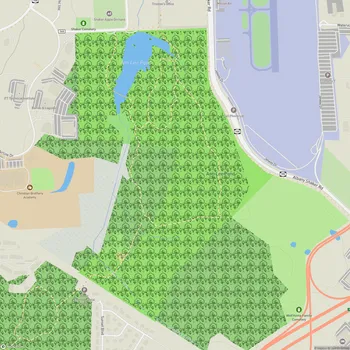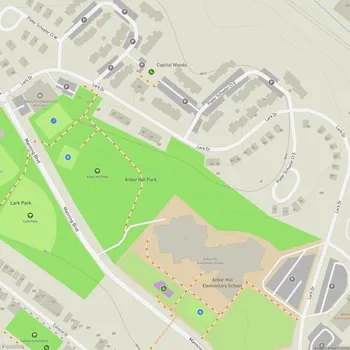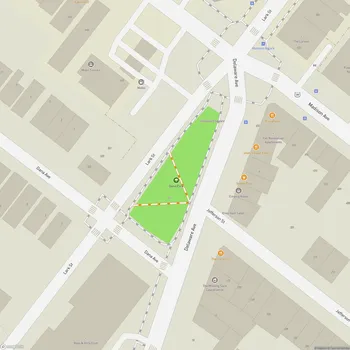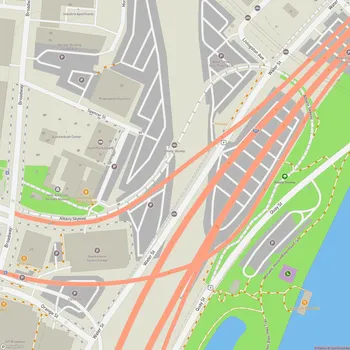Washington Park
Interactive Park Map
About Washington Park
Historic Origins
Positioned in the heart of Albany, New York, Washington Park stretches across 81 acres of urban greenery. Born in the 1870s, this park came to life through the vision of designers John Bogart and John Cuyler, who channeled many of the same philosophical ideals that Frederick Law Olmsted used for Central Park - though contrary to popular belief, Olmsted himself never actually designed this Albany escape.
The land has worn many hats throughout history - from gunpowder storage site to parade ground to cemetery. In 1972, the park became the centerpiece of the Washington Park Historic District, earning its well-deserved spot on the National Register of Historic Places.
Natural Features
Wander through Washington Park and you'll experience a thoughtful blend of formal and informal landscapes. Paths wind through open fields and wooded areas, leading eventually to one of the park's crown jewels - the 5.2-acre Washington Park Lake in the southwestern corner. This serene water feature came to be in 1873 when engineers dammed the Beaver Creek.
The lake now provides a home for various fish, turtles, and waterfowl that paddle about its surface. With over 100 species of trees throughout, it's no wonder locals often refer to this space as the "green lungs" of Albany - a peaceful breathing space amid the urban bustle.
The rose garden deserves special mention, with its hundreds of varieties creating a fragrant, colorful display during blooming season. Dedicated park employees keep the gardens and grounds meticulously maintained year-round.
Park Structures
As you explore, you'll come across the Lake House, a Spanish Revival building from 1929 that replaced an earlier wooden structure. Here you'll discover public restrooms and water fountains when you need a quick break. History buffs might appreciate knowing that the oldest original structure still standing is a charming footbridge over Washington Park Lake that dates back to 1875.
The architectural significance extends beyond the park itself - many surrounding buildings were designed by prominent late 19th century architects, creating a cohesive historical atmosphere. Within the grounds, statues and monuments like the Moses statue serve as artistic landmarks that tell stories of the past.
Recreational Facilities
Whether you're looking to break a sweat or entertain the kids, Washington Park has you covered. Active visitors can take advantage of the tennis courts, basketball courts, and skate park, while families gravitate toward the multiple playgrounds. Dog owners appreciate the dedicated dog park area where four-legged friends can run free and socialize.
The network of walking and jogging paths makes this a natural choice for your daily exercise routine or a peaceful afternoon stroll. Recent improvements have limited car traffic through portions of the park, creating a safer, more peaceful environment for everyone on foot.
Events and Recognition
The park hosts numerous community gatherings throughout the year. May brings the annual Tulip Festival, when thousands of tulips burst into a rainbow of colors, drawing flower enthusiasts from across the region. The Pride Festival brightens June with celebration, while summer evenings feature cultural events and outdoor theater performances at the park's amphitheater.
Even winter brings its own quiet charm to the pathways and open spaces, however the once-popular winter drive-through light display is no longer held. The park's significance received formal recognition in 1998 when the American Association of Architects named it one of the nation's 100 most important parks - highlighting its importance to both Albany and American cultural heritage.
All Features & Facilities
Active Recreation
Nature & Wildlife
Water Features & Activities
Visitor Services
Food & Gathering
Photo Gallery
ParkMagnet Score
Great Park
Park Size
Opening Hours
Hours not availableWeather
Top Restaurants Near Washington Park
Fusion
190 feet454 Madison Ave, Albany, NY 12208
Authentic Pan-Asian fusion restaurant featuring fresh ingredients, homemade sauces, and dishes blending multiple cultural flavors.
Villa di Como Ristorante
515 feet286 Lark St, Albany, NY 12210
Authentic Northern Italian restaurant featuring handcrafted pasta, fresh seafood, and house-made limoncello in elegant downtown setting.
Suwun Thai Home Cooking
0.2 miles234 Western Ave, Albany, NY 12203
Authentic Thai restaurant serving flavorful dishes like basil chicken and pumpkin curry in a beautifully decorated atmosphere.
Top Hotels Near Washington Park
The Argus Hotel & Cocktail Lounge
440 feet8 Thurlow Terrace, Albany, NY 12203
Historic boutique hotel featuring refined quarters with kitchens and an on-site cocktail lounge in downtown Albany.
Hilton Garden Inn Albany Medical Center
0.4 miles62 New Scotland Ave, Albany, NY 12208
Contemporary urban hotel featuring comfortable rooms, on-site restaurant and bar, plus convenient medical center proximity.




